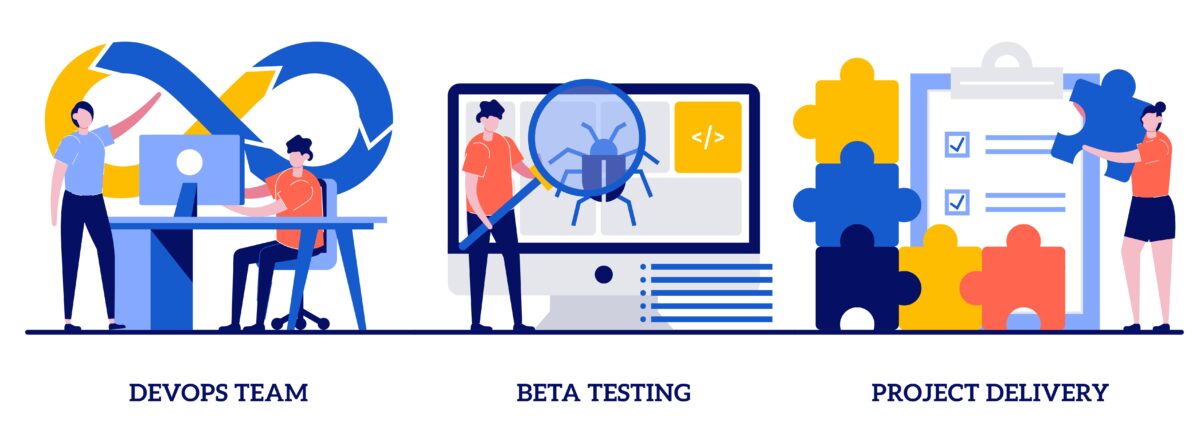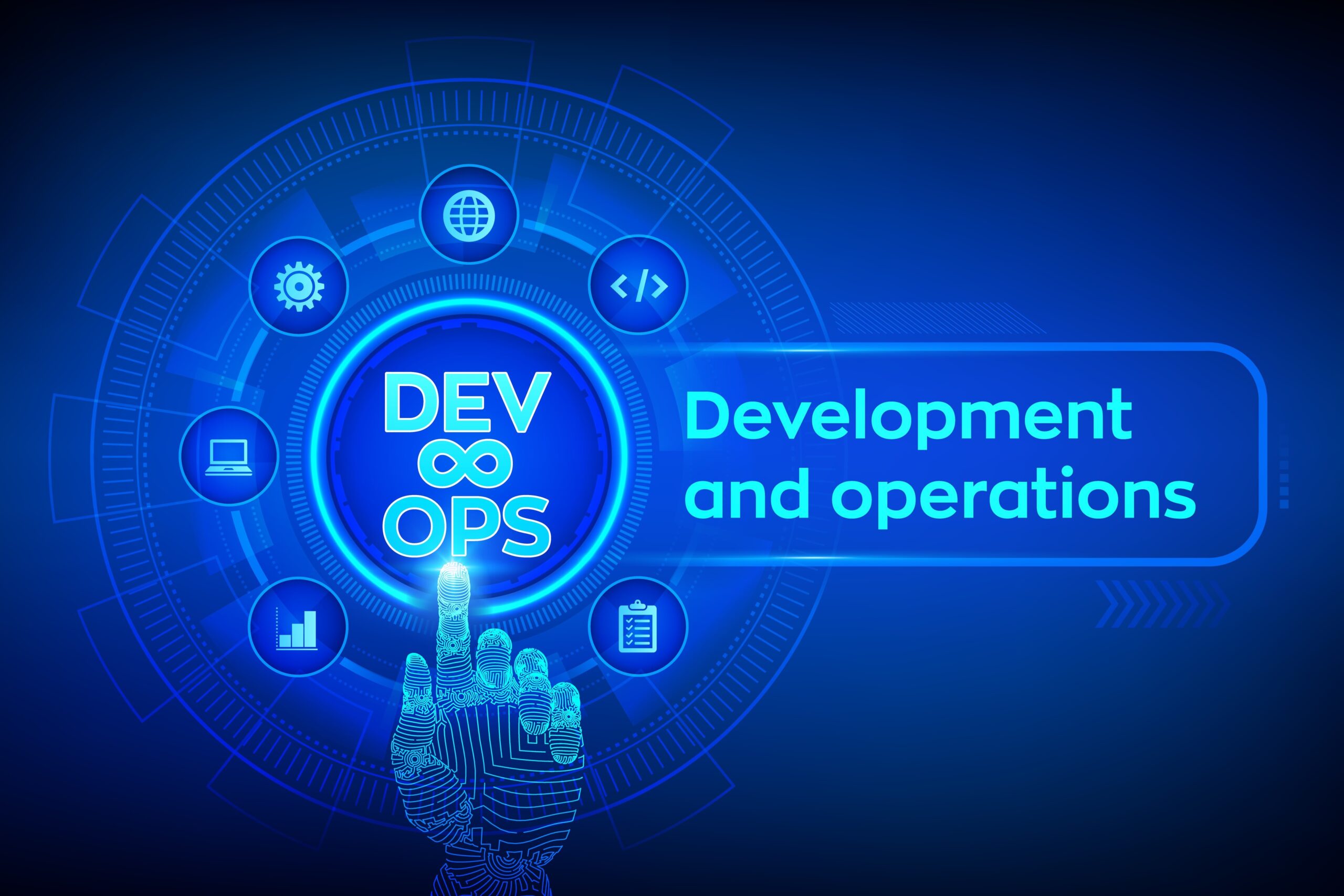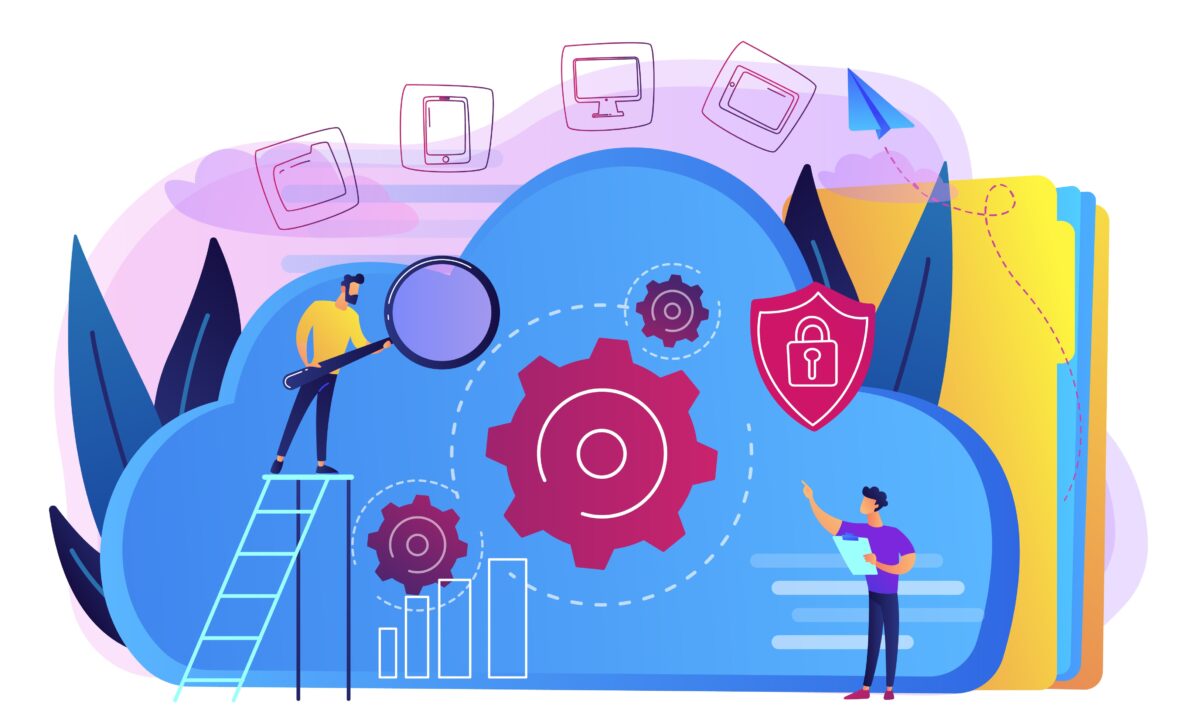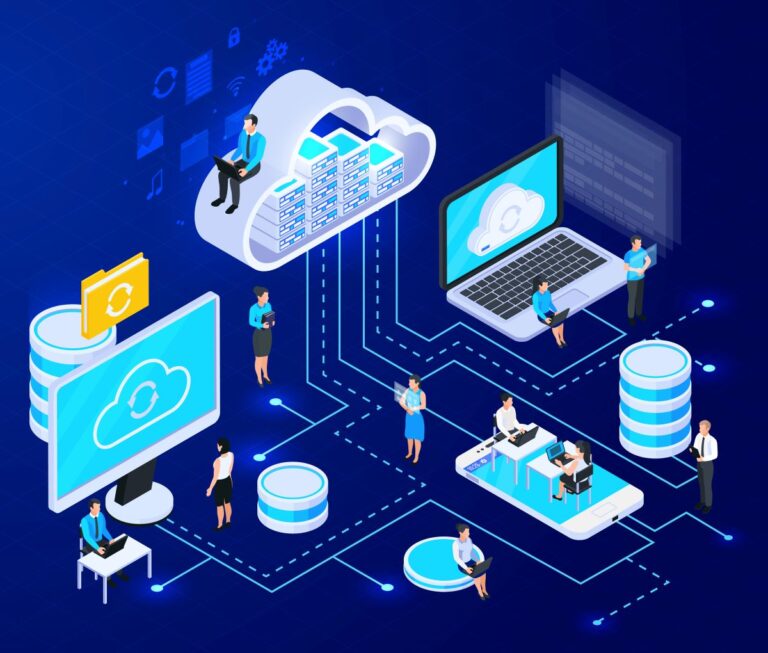The DevOps movement is growing rapidly.
We live in a world where technology changes faster than ever before, and if you want to compete, you need to have a DevOps strategy in place to help you stay ahead of the curve.
According to a recent report published by Acumen Research and Consulting, the global DevOps market size accounted for USD 7,398 million (mn) in 2021 and is expected to reach USD 37,227 mn by 2030 with a considerable compound annual growth rate (CAGR) of 20% during the forecast timeframe of 2022 to 2030.
Many startups, SMEs, and enterprise organisations are adopting DevOps practices as part of their ongoing digital transformation efforts.
This guide will explain the DevOps mindset and show you how to build your DevOps strategy.
2. Why Do Organisations Adopt DevOps?
4. The Top Five DevOps Mistakes
5. How to Plan a DevOps Successful Implementation
6. Case Studies: 5 Successful DevOps Stories
What Is DevOps?
DevOps is a term often used interchangeably with Agile or Lean (methods for project management) and that’s okay.
In reality, DevOps is much broader than just being Agile or Lean.
DevOps is the practice of automating, coordinating, monitoring and integrating development processes for a software system. It has become a popular choice of technology companies that are looking for better ways to streamline their development process and optimize their operations workflow.
In the early days of DevOps, DevOps was mostly used by technology companies that were looking for ways to build better systems. They were looking to build faster systems and automate and coordinate their development process.
In a nutshell, they were looking for ways to speed up their software delivery pipelines.
DevOps can refer to several different approaches, tools, and techniques that are designed to facilitate the rapid development of quality software.
But, the main principle behind DevOps is an integrated approach that involves cross-functional collaboration between development, operations, quality assurance, product management, and customer support teams to reduce the time it takes to deploy new software.
The primary benefits of a DevOps approach include reduced risk, increased productivity, enhanced agility, and improved operational efficiency.
Why Do Organisations Adopt DevOps

The goal of the DevOps movement is to help organisations better collaborate across teams to develop and release software more quickly.
Many companies have adopted DevOps principles and techniques as part of their strategy to modernize their software delivery pipeline.
By combining DevOps principles with Agile practices, companies can reduce the risk of failing and increase the quality and speed of their software delivery pipeline.
In many cases, it’s because organisations have realized that the costs of running their software development pipelines without automation are too high.
According to research conducted by DevOps.com, the average cost to develop a line of code is $14,500. That is a lot of money! This cost is often spread among multiple developers, quality assurance and operations staff, IT staff, and even executive management. With every change in the code, the cost is added.
With DevOps, you can significantly reduce the total cost of developing your application.
Besides reducing the cost of production, DevOps can increase quality and speed up the development process.
DevOps Practices and Tools
As technology has evolved, so too have the practices that make up DevOps.
The goal of DevOps is to enable organizations to collaborate across their teams to develop and release software faster.

It, therefore, includes practices such as continuous integration (CI), continuous delivery, and continuous improvement.
From CI and continuous deployment to the development of microservices and containers, DevOps is about making sure that software gets built and deployed every day.
CI is a practice that helps to integrate changes into your app. This practice makes sure that all the components of an app are integrated and work together properly. CI builds, tests, deploys code continuously, and makes sure that the code you write is working well.
This is especially useful for building apps for web, mobile, and Internet of Things (IoT).
DevOps combines several tools and technologies to provide developers with the tools and infrastructure they need to develop and deploy software faster and more efficiently.
Some of these include (i) automation, (ii) continuous integration (CI), (iii) continuous deployment, (iv) continuous delivery (CD), (v) continuous monitoring and alerting, and (vi) configuration management.
(i) Automation
Automation is done through tools such as Jenkins, GitHub, and TravisCI to automate and coordinate the process of testing and releasing software.
These tools help streamline the process of making changes to code that makes it easier for the developer to update and deploy the software without having to worry about quality control.
Automation tools help keep track of what changes have been made to the codebase and allow the team to know when there’s a new release available.
(ii) Continuous Integration (CI)
Continuous integration (CI) means that every time you build a change to the code, you run unit tests to ensure that the changes are not breaking anything.
It can help you to find and fix errors. Once you’ve fixed the errors, it can also help you to check that the code has been tested before it is released to the public.
This way, you won’t release code that contains any bugs. It will also make sure that your code is well-tested and that everything works.
With continuous integration, you can set up tests and make sure that they work before releasing them.
This can reduce the amount of time that it takes for developers to do testing and make changes. This also helps the developers to be more efficient.

(iii) Continuous Deployment
Continuous deployment is becoming the new normal in DevOps. When it comes to software development and application deployment, continuous deployment means that changes are made quickly to the product.
If there are problems with the code that causes problems, the change is rolled back and fixed immediately. If everything goes according to plan, the change is deployed and put into production.
The goal of DevOps is to bring continuous deployment to all types of applications.
Continuous deployment can increase the pace of development, speed up the product lifecycle, and increase the reliability of the application.
(iv) Continuous Delivery (CD)
Continuous delivery (CD) enables you to release your changes as soon as you are done developing them.
It is an automated process that allows you to develop software with fewer bugs.
When you have continuous delivery, you can make a new change to a program without having to wait for the code to compile and be tested.
This means that your customers are always using the latest version of your code.
As a result, your team doesn’t need to be involved in long deployments, which means that your team can work on more features and solve problems.
(v) Continuous monitoring and alerting
Continuous monitoring and alerting is a way of ensuring that you have a continuous supply of information.
This allows you to detect problems with your application before they cause you any harm.
For example, if a build fails in a production environment, you don’t just have to sit back and wait. You have to respond immediately. DevOps calls this continuous monitoring and alerting.
DevOps teams automate all sorts of tasks that were previously handled by humans. One of these tasks is monitoring, especially in environments with complex infrastructure.
The team watches for signs of a problem and reacts accordingly. They can react faster, and with less effort than human operators would need to.
(vi) Configuration management (CM)
Configuration management (CM) is a term used to describe processes and methodologies that are used to manage changes in software or technology systems.
While many IT operations teams have been using CM for years, it’s still a new concept for many developers and operations professionals.
The DevOps community has created a lot of buzz around DevOps because of the movement’s emphasis on automation, collaboration, and continuous delivery.
Many organisations realised that their business objectives can only be achieved by aligning DevOps practices with their IT operations.
The Top Five DevOps Mistakes
Is DevOps a game-changer for the tech world?
Let’s take a look at some of the reasons why it might not be.
1. Not automating application deployment
Automation is a key part of DevOps, and there are many ways to automate your deployments, but a lot of people miss a very important part of this process: the deployment itself.
If you don’t deploy your code often enough, you can end up with an unmaintainable, difficult-to-manage mess of code, or even a version of your application that doesn’t run properly.
The key here is that automation is not just about how to set up your environments; it’s also about how to manage and keep track of those environments.
If you’re still using manual processes for application deployments and upgrades, you’re probably missing some opportunity to save yourself or your company money.
2. Not testing your continuous integration and delivery (CI/CD) system
If you want to have an effective continuous integration and delivery (CI/CD) system, it’s important to test it and make sure it works as expected.
But you can’t just test it once; you have to test it again and again. And to do that, you need to have a CI/CD system that’s automated.
Most CI/CD systems are manual; there is no automation.
Some organisations think that they can test once and move on, but the reality is that you should constantly test your CI/CD system, especially when there’s a change to any of the components.
3. Not monitoring your production environment
If you’re not monitoring your production environment, you don’t know what’s going on, you can’t see what’s going wrong, and you can’t fix it.
At its core, DevOps means being able to respond to the needs of your business by providing support.
With DevOps, it’s all about making the business better.
To achieve this, you need to be able to respond quickly to problems and identify them before they become serious.
4. Not building your infrastructure by cloud best practices
Most infrastructure projects fail because they weren’t built correctly.
Whether it’s a private cloud, public cloud, or even a hybrid model, the right infrastructure will help organizations meet the demands of their business and increase employee productivity.
To help prevent this from happening, it’s important to have a thorough understanding of your infrastructure and a clear plan for how to improve it.
5. Not using version control
Most business owners don’t realise the power of version control.
Many think that version control is a system designed for big corporations. That couldn’t be further from the truth!
Version control allows you to track the changes made to your code, your design files, or even the content in your CMS. This tracking can provide insight into how the website was built and used over time, giving you valuable insight into how it performs.
It allows you to create a change log and even a changelog for content management systems that are widely used.
In addition to making the site more accessible, version control also allows you to quickly roll back to any previous state should an error arise.
It ensures that no one else can accidentally delete something or introduce bugs into the project.
How to Plan a DevOps Successful Implementation

DevOps is a hot topic right now and one that many are adopting as part of their enterprise transformation. However, many organizations are adopting it and don’t see any real results.
Why is that? Is the problem in execution or planning?
According to Gartner, it predicts that “through 2022, 75% of DevOps initiatives will fail to meet expectations due to issues around organizational learning and change”.
“ People-related factors tend to be the greatest challenges — not technology”
George Spafford, Senior Director Analyst, Gartner.
Therefore when implementing a successful DevOps strategy, it is important to look at the following steps to address people-related factors.
1. Find a mentor
Finding a mentor is important because it can help you a lot. The mentor will teach you about the things you need to know to be a good DevOps practitioner.
You can find them at DevOps meetups, DevOps conferences, online forums, or even local user groups.
You may also find a mentor who works for your organization. Look for him or her around the office, but don’t be afraid to ask your boss if there is someone you can talk to.
2. Hire the right people for your team
Look for people with the right attitude for adopting DevOps practices.
The team should demonstrate values of accountability, teamwork, and lifelong learning. The right team culture has a profound impact on DevOps adoption.
3. Create a culture of collaboration

It is important to establish a culture of collaboration among the team to run successful DevOps.
Break down barriers and work together between teams. Rather than work in uncoordinated silos, teams should adopt a collaborative working style.
To create a culture of collaboration, it is important to provide opportunities for people to interact with one another.
This means that you should encourage your people to interact with others from other departments, outside of your organization.
For example, when a customer needs support, the customer service representative should talk with the development team. The development team should be willing to explain what they are doing to the customer service representative. Similarly, people should be willing to share information about new features with other people.
4. Consider the business goals and outcomes
Before you can set up a DevOps implementation, you need to have a clear picture of the company’s business goals. Set the right goals and objectives.
Consider how you will use DevOps to achieve the business goals and outcomes that the company needs to accomplish. This might involve using DevOps to develop better applications and tools.
A company that is working on improving its business by developing new apps and tools is going to experience success.
It is also important to manage expectations for what DevOps can deliver. Identify customer value continuously using marketing tools to gain market insights about your customer base.
5. Start small
Start with a small piece of the system. Don’t try to launch DevOps in one go.
Figure out the smallest part of your infrastructure that can be successfully developed, tested, and deployed. Once you’ve succeeded, the rest will be easier.
The organization should continue to focus on improving continuously and continually establishing the right working style and collaborative culture among the teams.
Use an iterative approach. For instance, if you’re a business owner, don’t start by deploying your software to all of your customers.
Instead, focus on getting it to just a few users, then a few more, and keep building.
Case Studies: 5 Successful DevOps Stories

There are hundreds of case studies where DevOps has helped to achieve better results. Some of these case studies have become very successful, and they have helped a lot of people in their businesses.
So, let’s take a look at five case studies that involve companies such as Amazon, Netflix, Microsoft, Facebook, and Google.
1) Netflix
A global media and entertainment company, Netflix started as a DVD rental service in 1998 and has since evolved into one of the largest internet content distributors in the world. In 2015, Netflix became the first streaming service to receive a $100 billion market valuation. The company uses DevOps to develop software for its servers, data centers, and user interfaces.
2) Facebook
The popular social community platform adopted a continuous delivery methodology to improve the quality of its services. With continuous delivery, Facebook can update its systems frequently, which means that it can fix issues very quickly. This allows them to release new features more often, which brings more engagement and more users to their website.
3) Microsoft
The DevOps teams at Microsoft were tasked with improving the overall efficiency and productivity of software development teams. They helped the IT groups move towards cloud-native application architectures. How Microsoft achieved this can be summed up in four simple words: culture change.
4) Amazon
One of the things that makes Amazon such a powerful company is its culture, says Tushar Jain, VP, Cloud Services, Amazon Web Services. Amazon has a culture of collaboration, transparency, trust, and mutual respect. It has no formal hierarchy; instead, employees work together to help the company succeed. This culture has been key to Amazon’s ability to build and scale cloud computing services.
5) Google
One example of Google’s successful DevOps approach is its cloud-based G Suite. Google is leveraging its massive scale to enable real-time collaboration across a large set of geographically dispersed teams.
In the case of Google’s DevOps project, the company was successful because it had the right skills in place to help with the development process. The company also had the right people on board to make the projects happen.
Conclusion
In today’s highly competitive IT marketplace, DevOps is becoming the new normal.
The goal of any DevOps strategy is to move fast, break things, and improve your entire application delivery pipeline.
However, to succeed, you must first decide whether DevOps is right for your business.
If you have decided that DevOps is the right approach for your business, you are going to need a plan that works.
Remember that DevOps is more than just moving code around or having better infrastructure. It is about a culture change in which developers and operations work together to improve the quality of software through better collaboration.
Read Future of DevOps: Top 6 Trends To Look Out For
Websparks is an award-winning Web Development Company based in Singapore.
Websparks is certified as a Microsoft Gold Application Development, Silver Application Integration, and DevOps Partner.
We are equipped with the tools and resources to deliver our clients the best quality of software development services and solutions. We have proven expertise in providing quality solutions in application development, integration, and DevOps.
Contact us for more information on the services that we provide.






